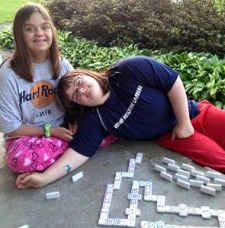Erin Feathers

*Update below, March 13, 2017*
Our 17-year-old daughter, Erin, began experiencing heart failure in January following an open heart surgery completed a month earlier to correct a heart defect (VSD), a defect fairly common with individuals with Down Syndrome. (Sepsis and Surgery) On February 5th, she was admitted to the University of Virginia Medical Center to determine the actual cause of the heart failure. Following a drastic drop in her blood pressure on February 12th, she was admitted to the hospital’s PICU. A cath procedure to correct the issue was delayed due to the discovery and surgical removal of a clot in her heart.
When the cath procedure was able to be performed, it proved to be unsuccessful. On February 20th, Erin experienced another drastic drop in her condition, and she ended up being placed on life support (ECMO). Blood clots developed during this period that required careful attention, and dialysis was begun to address the decline in her kidney functioning. On February 26th, her doctors informed us that our daughter had been suffering the effects of endocarditis, a serious heart infection. This infection eventually spread throughout her body as sepsis and was aggressively treated with 4 different antibiotics.
As Erin laid in a drug-induced coma, my wife and I sat at her side day and night, concerned about her roller coaster blood pressure, her blackish-blue fingers and toes, her labored breathing (requiring long periods of intubation), and her erratic heart functioning. On March 10th she experienced a very unexpected, drastic drop in her blood pressure resulting in little to no blood perfusion to her extremities. The doctors discovered a clot behind her heart that required emergency surgery. We were told that she had less than a 50% chance of surviving this surgery. Following the surgery, her acidosis number skyrocketed, and her body systems started to shut down.
During the course of the night, Erin amazed the medical team as the acidosis number steadily declined. She was fighting for her life. Erin remained in PICU until April 8th, spent a few days in the IMU, and was moved to ‘the floor’ until her discharge on April 28th. She is home now and is very much in a weakened state, but she’s getting better every day. She is still on dialysis and on several different medications, but we are just grateful that she is alive and is on the mend.
The experience has been life-changing for us. We’re constantly on the lookout for anything unusual in her condition. We are trying to regain a sense of normalcy, but we know that her present condition has caused us to find a “new normal” that focuses much of our waking hours catering to her needs…even as the needs of our other children require attention. “Whatever it takes” has become our family’s slogan. Whatever it takes to keep Erin healthy, happy, and out of the hospital. She is doing so much better than even a month ago…and we look forward to continued gains in her condition. Thank you for providing this site for those seeking more info on sepsis and its devastating effects.
Update from Rob, March 13, 2017:
Finding this site and reading the stories of hope from survivors of sepsis and septic shock gave me hope and determination in my journey with my daughter, Erin, sitting up in the photo below. During the past 10 months following her discharge from the hospital, she was able to enjoy a family vacation at the beach, her 18th birthday, and Christmas, which she loved. She fought so hard to be among us, to be involved with us, to stay healthy and to be happy. We fought right along with her…every step of the way.
On Feb. 13th, Erin’s health was attacked again and this time sepsis ended up overcoming her. It snuck up on us. She never really did regain her health during the 10-month period that she was home, remaining very weak. She underwent nightly dialysis treatments and had a g-tube inserted into her stomach for nutrition and to administer her many meds. The “hole” in her stomach failed to ever heal and just got bigger and more unmanageable, with leakage and bleeding being frequent problems/concerns. Her doctors never did seem to really get a handle on how to help this area heal.
On the morning of Feb. 13th, we woke her up to get her ready for a medical appointment to again address the g-tube site. Her blood pressure was 70/30 (not too unusual for her morning reading) and she was extremely weak. The rescue squad was called, and during the ride, she seemed to bounce back a bit. Upon being admitted, the medical team immediately began a sepsis protocol with an antibiotic IV and rehydration. She seemed to be doing OK and was admitted for observation, especially of the g-tube site. That evening, around 7:30 p.m., Erin became unresponsive, with an almost negligible blood pressure and a very low pulse rate. An hour later she was gone from us. Almost a month ago. The pain of losing her to sepsis after overcoming it last year is unbearable. To you survivors, keep fighting. All of you are my heroes. And to the families that have lost a loved one due to septic shock, I join you in your pain and agony. Love to all.
Source: by Rob Feathers (Erin's father)






























